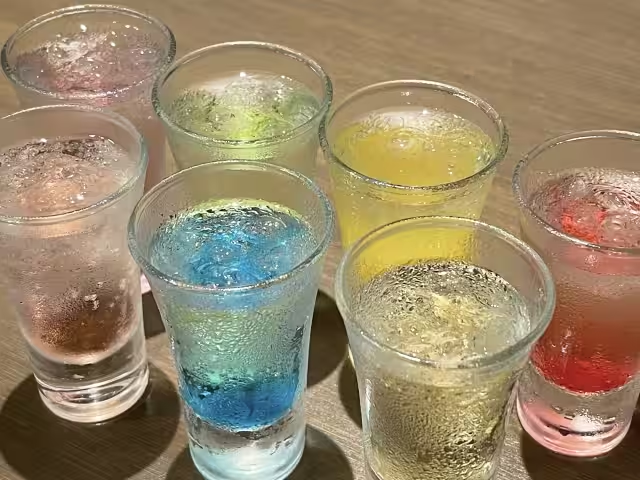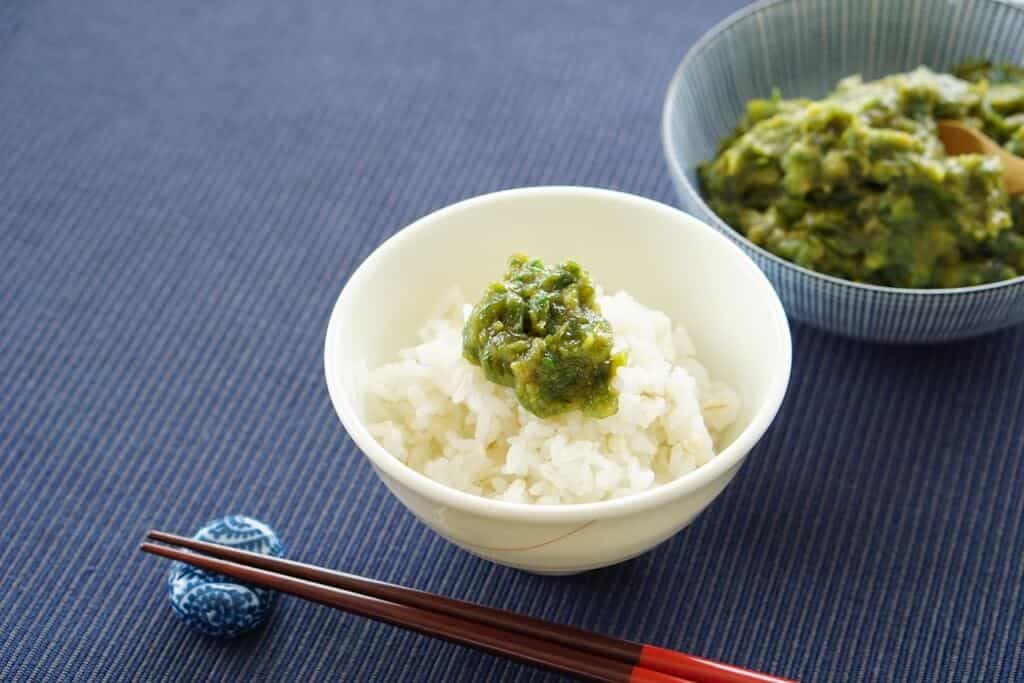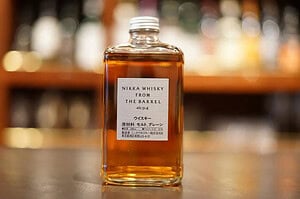Chuhai, a popular drink in Japan, is a delightful mix of simplicity and variety. Known for its refreshing taste and endless flavor options, it has become a staple at izakayas and casual gatherings. Whether you’re enjoying a classic lemon chūhai or exploring creative twists, this drink offers something for everyone
What is Chuhai?

Chūhai (チューハイ or 酎ハイ), short for “shōchū highball” (焼酎ハイボール), is a popular Japanese alcoholic drink. It doesn’t have strict rules or legal definitions but usually refers to a mix of a neutral alcohol like shōchū or vodka with fruit juice or other flavorings, often combined with carbonation. The flavors can vary widely depending on the ingredients. Even non-carbonated drinks, like oolong high (made with oolong tea), are considered a type of chūhai.
Etymology
The term “chuhai” originates from combining two key elements: the “chu” from shōchū (a traditional Japanese distilled spirit) and the “hai” from “highball” (a type of mixed drink commonly served in a tall glass). This name reflects the drink’s basic concept, which involves mixing shōchū with carbonated water and additional flavorings, similar to a highball.
Chuhai History

The origin of the shochu highball dates back to 1951 at Sanyu Sakaba Yahiro Branch, a bar believed to have created this iconic drink. Inspired by the whiskey highball he encountered while working at the American occupation forces’ garrison, Yuji Okunogi, the uncle of the bar’s former owner, experimented with shochu to create a similar drink. At the time, shochu had a strong smell due to poor-quality ingredients, but mixing it with soda made it more enjoyable and accessible. The amber color of their chuhai reflects its whiskey highball inspiration, symbolizing the resilience and hope of postwar Tokyo as people sought joy in simple pleasures.
Types and characteristics of Chuhai

In recent years, chuhai has become popular with many people due to its convenience and wide variety of flavors. The range of alcohol content and flavor variations is wide, making it appealing to choose according to the scene or mood. From classic citrus flavors such as lemon and grapefruit to fruity options overflowing with juice, to special flavors incorporating umeboshi and tea, there is a wide variety to choose from. In this article, we will categorize chuhai and introduce the characteristics and ways to enjoy each type. Use this as a reference to find your favorite.
Regular Chuhai
Alcohol content: 5-7%
Characteristics: With a moderate alcohol content, it has a well-balanced taste. Many canned Chuhai fall into this category, with the most popular products available. Citrus flavours dominate, providing a refreshing taste that goes well with food.
Representative products: Kirin’s “Hyouketsu”, Suntory’s “Kodawari Sakaba no Lemon Sour”, Asahi’s “Zei Taku Shibori”, etc.
Scene: Popular as a drink for evening relaxation or during meals, this type is often enjoyed in everyday settings.
Strong Chuhai
Alcohol content: 7%-12%
Characteristics: With a high alcohol content, it offers a robust taste and is popular with those who like to get tipsy easily. Compared to regular Zhuhai, it tends to be less sweet and often has a crisp aftertaste. Care should be taken not to overindulge.
Representative products: Suntory’s -196ºC Strong Zero, Asahi’s Clear Cooler, Kirin’s Hon Shibori Chuhai Strong, etc.
Scene: Often consumed when seeking a strong intoxication or during a period of relaxation, care must be taken to avoid excessive drinking.
Low alcohol Chuhai
Alcohol content: Less than 4%.
Characteristics: Its light taste makes it perfect for those who do not like alcohol or for beginners. It often has a sweet flavour, making it similar to juice. It’s popular with women and younger generations because it’s easy to drink.
Representative Products: Suntory’s “-196ºC Strong Zero,” Asahi’s “Clear Cooler,” Kirin’s “Hon Shibori Chuhai Strong,” etc.
Scene: Often consumed when seeking strong intoxication or during relaxation time, care must be taken to avoid excessive drinking.
Non-Alcoholic Chuhai
Alcohol Content: Less than 1%
Characteristics: Contains almost no alcohol, allowing for relaxed enjoyment like juice. It suits those health-conscious or those wishing to avoid alcohol, with more easy-to-drink products available. Even non-alcoholic options provide a genuine cocktail feel and refreshing carbonation.
Representative Products: Suntory’s “Non-Alcoholic Mood,” Asahi’s “Zero Kaku,” Kirin’s “Kyasumu Hi no 0.00%,” etc.
Scene: Functions well during driving, when conscious of health, or during work breaks, in various situations.
Fruit Chuhai
Alcohol Content: 3% – 7%
Characteristics: Many use abundant fruit juice, offering a wide range of flavors not only from lemon and grapefruit but also peach, pear, grape, apple, yuzu, etc. It has a strong fruit juice flavor with a sweet and tart freshness, particularly popular in summer.
Representative Products: Asahi’s “Zei Taku Shibori,” Kirin’s “Hon Shibori,” Suntory’s “Horo Yoi Momo,” etc.
Scene: Seasonal fruit flavors are available, so many limited-time offerings exist, appealing to those who enjoy the fruitiness of alcoholic drinks.
Special flavours
Alcohol content: 5% – 7%
Characteristics: Chuhai has unique flavours such as pickled plum, tea and spices, which have gained attention in recent years. For example, products that highlight the saltiness of pickled plum or the astringency of tea are excellent food accompaniments. They appeal to those who love distinctive flavours or are looking for new tastes.
Representative products: Sapporo’s “Otoko Ume Sour”, Suntory’s “Midori Gin Soda Can”, Asahi’s “Green Tea for Japanese Cuisine”, etc.
Scene: Often enjoyed with meals or for a change of mood, particularly appealing to adult tastes.

Beware of overindulgence
It’s important to drink in moderation, especially with strong types due to their high alcohol content.
Using the variety of flavours and alcohol levels to find the right drink for you is one of the main attractions of chuhai. Whether you enjoy it with friends and family or on your own, there are many ways to enjoy it, ensuring that its popularity will continue to grow.
The difference between Chuhai and Sour

The term “sour” comes from the English word meaning “sour.” A sour is a type of cocktail made by mixing a base alcohol, such as spirits, with sour fruit juice like citrus and a sweetener like sugar, often topped with soda. In terms of recipes, there’s little to no difference between a sour and a chuhai. Some izakayas (Japanese pubs) refer to this drink as chuhai, while others call it sour, so the two terms are often used interchangeably.
Homemade Lemon Sour Recipe
| Lemon Sour Ingredients for 1 person | Measurements |
|---|---|
| Lemon sour base (lemon syrup and shochu) | 30-50g |
| Lemon juice | 5-10g |
| Carbonated water | 150-200g |
| Lemon slices | 5g |
How to make Lemon Sour?
Use untreated Japanese lemons (preferably harvested between December and May) for their aromatic peels. Combine the lemon peels with sugar to create a syrup. Then, mix the lemon syrup with shochu and allow it to infuse for a few days to enhance the flavor.
Place 1–2 lemon slices in a glass and add the prepared lemon syrup. Add the infused shochu, depending on your preferred alcohol strength. Then, pour lemon juice for extra tartness. Stir the syrup, shochu, and lemon juice thoroughly.
Add strong carbonated water to the glass. Gently mix the drink and adjust the sweetness or strength of the alcohol to your liking.
Chuhai Restaurants
Ojinjo (おじんじょ)

At Ojinjo, the usual fresh lemon chu,” makes customers feel like regulars. Renowned for its lemon chuhai, the establishment offers an impressive variety, with six different types of lemon chuhai alone. Each variation tempts patrons to try them all. Among the options, the combination of ginger, salt, and mint paired with the zesty lemon stood out as a highlight.
Tachinomi Jinbei (立ち飲みじんべえ)

At Tachinomi Jinbei, a standing bar with their signature drink. It features a generous pile of frozen lemon slices, which gradually melt as the you enjoy the drink. By the third glass, the lemons reach their perfect state, with up to four glasses possible from the same batch. Despite being a standing bar, it attracts many female customers.
Takeaway

WIth its variety of flavors and easygoing nature, it’s no wonder that chūhai is a favorite among locals and visitors alike. If you ever find yourself in Japan, make sure to try it out—whether at an izakaya, a convenience store, or a local bar. We hope you’ll enjoy this iconic Japanese beverage and take home a taste of Japan’s drink culture!
We highly recommend exploring some of the unique Japanese drinks to deepen your appreciation of Japan’s vibrant drinking culture!
















Comments